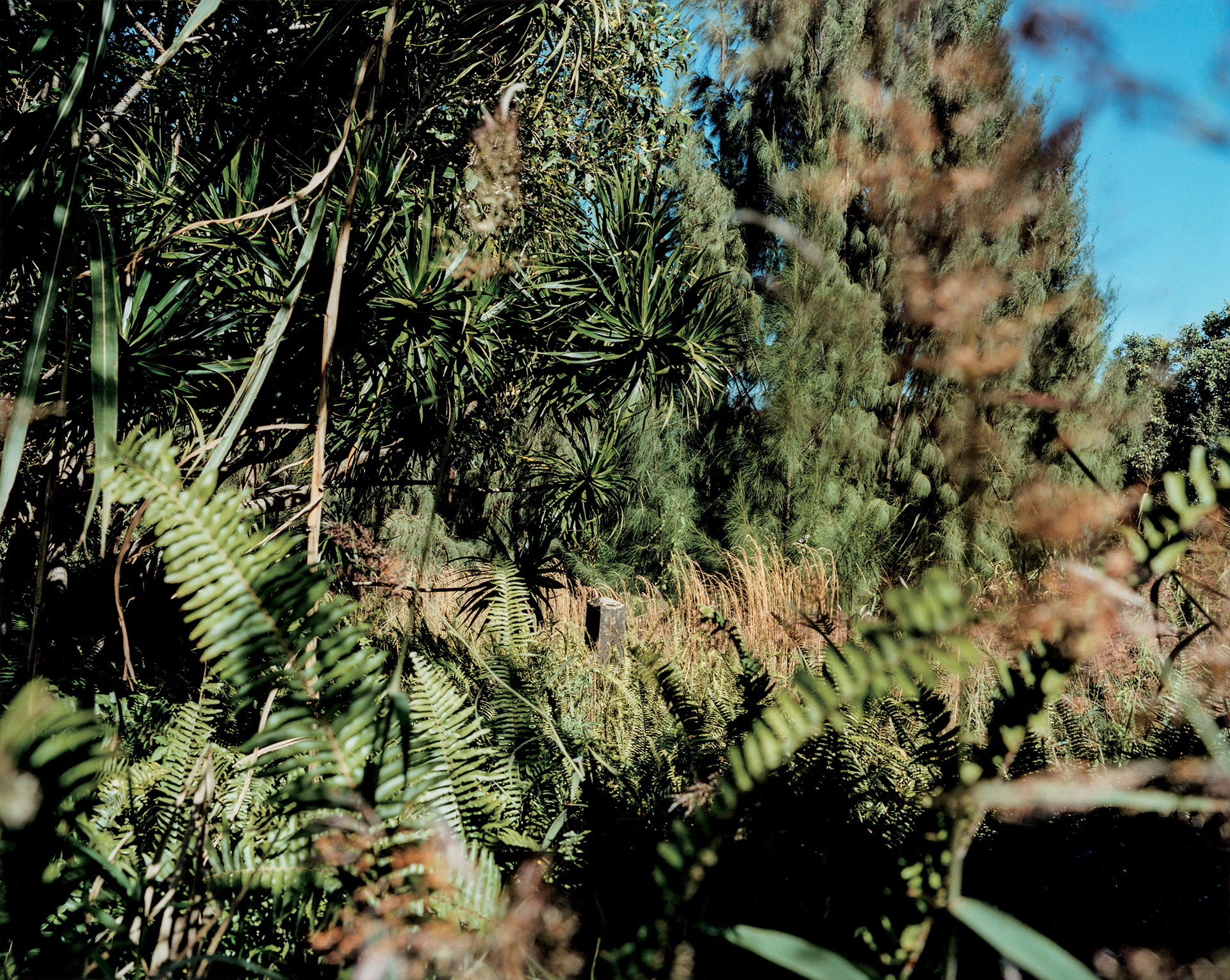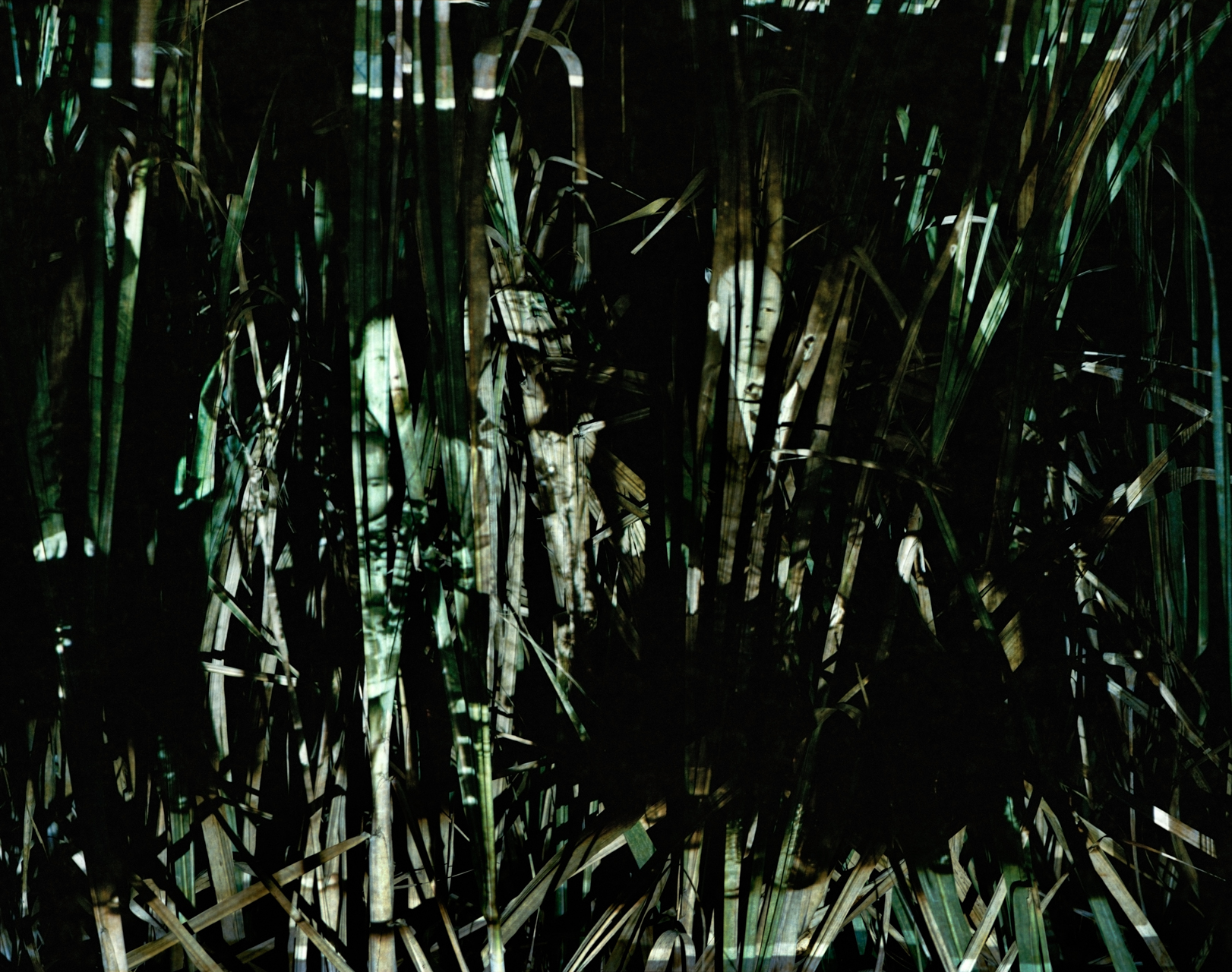Ai Iwane
A Faceless Person
 Ookala, Hawaii, 2006
Ookala, Hawaii, 2006 from the series KIPUKA
"It's behind here," said Nick Kato, stopping the car. We got off on the bridge on Route 19 and as we went through the bush, I noticed a royal poinciana tree.
"The first time I came here the Japanese school sign and the building were still here," said Nick. As we walked on an animal trail, I suddenly felt like I had cut into a spiderweb as I ran into a boundary. Looking down, I saw a tombstone covered with weeds. On the concrete tombstones, I could see very faint writing and Nick said: "There once was a sugar cane plantation here, Ookala." Nick understands the history because he moved from Japan and lived on the Big Island for over 40 years.
The cemetery is in one of the ‘camps’ as they used to be called, which were the living quarters for the cane laborers in the plantation. During the heyday of the sugar industry, Hawaii was home to numerous sugar refineries and countless ‘camps’ like this one were located on vast plantations.
A Royal Poinciana is often found standing like a landmark where there used to be a Japanese community; Japanese language school, temples, and cemeteries once existed here. People called it a Shower Tree because countless tiny blossoms fluttered down like a shower. Did people plant this shower tree instead of Cherry-Blossom trees, I wondered.
After the farm's closing, some graves were relocated, others were forgotten and abandoned with no caretakers to look after them. Encountering these unknown tombstones was like meeting people, without seeing their actual faces. One person here, another person there, I could sense their existence in the field.
I began to picture the village as my eyes got used to the dark and as if I gained a broader view and the tombstones seemed to ask: "Who are you? Why are you here?"
The tombstones were covered with thick ferns, shaped like a figures and it felt like they were the descendants of unknown people reaching out to me. I continuously released my camera shutter, capturing the faceless human figures that appeared one after the other.
"You are leaving already?" the tombstones appeared to say.
The town supporting the sugar plantation disappeared with the end of the industry sector. I was haunted by the breath of human souls and the vanished town that I felt from the remains of the tombstones.
Nick commented: "There are places like this all over Hawaii."
Leaving the Ookala with a painful heart, I thought to myself: If there are many more places like these in Hawaii, I want to find them. I will collect information about the camps. I will look for the forgotten cemeteries and I promised myself: “I will come back. I will."
That was in 2006, the first year I visited the island of Hawaii. My journey started then by looking for the names of the faceless people and visiting the six islands where the Japanese had migrated, Kauai, Oahu, Maui, Molokai, Lanai, and the Big Island. Encountering an unknown cemetery began with meeting someone who cares about it. If I can meet such a person and ask them to lead me into the depths of the landscape, I can reach the Issei – the first generation now in quiet sleep.
While I was in Maui in 2014, a congregation from Hongwanji Temple asked me if I wanted to go along to see the old cemetery, they found in the middle of a sugarcane field. The old document that showed the lease contract of the cemetery located in the premises of Hawaiian Commercial & Sugar Company was found at Paia Hongwanji long ago.
Rodney Chin, the manager of HC&S farm arrived in a big pick-up truck. He took us to the middle of the field and began walking through the sugar cane jungle. Rodney made his way through using his sugarcane knife. As we followed in between the sugarcane as tall as myself, I began to spot tombstones one after the other. A Buddhist name is engraved on the front. On the side, is engraved the place of birth of the deceased.
Katsuzo Moriguchi
22 years old
October 31st, 1910
Yoshida-mura, Shinobu-gun, Fukushima
Katsuji, third son of Kyuzo Sakuma
8 years old
January 8th, 1919
Shimo, Sakura-mura, Shinobu-gun, Fukushima
Matsutaro Ogami
23 years old
Date unknown, 1909
Hiroshima
Masayo, first daughter of Osamu Watanabe
November 7th, 1911
Hiroshima
First son of Seiichi Kasuya
November 2nd, 1910
Yamaguchi
Rodney said: "It's looking worse than the last visit," When Rodney finds a new tombstone he cuts the grass, I take pictures and notes. Even though I told him that the engravings are eligible on the tombstone, he never stopped cutting the grass. I suddenly noticed a streak of blood coming down his hand.
Kay Fukumoto, who came along with us, told us that her great-grandfather lived here, and the road sign read: “Keahua.” At that moment, covered in the sugarcane, I saw her great-grandfather's face in the photo Kay had shown me the night before.
 Tomijiro Watanabe, Keahua Camp, Maui, Hawaii, 2016
Tomijiro Watanabe, Keahua Camp, Maui, Hawaii, 2016 from the series KIPUKA
Ai Iwane is a Tokyo-based photographer who studied in the United States where she led an off-grid and self-sufficient life. She began her career as a photographer in 1996 focusing on assignments for magazines and various music-related work and 2006 she shifted the focus of her attention to the culture of Japanese people in Hawaii. Since 2013, she has been partly based in Miharu, Fukushima, her work in recent years is mainly themed on the connection between Hawaii and Fukushima as embodied by immigrants. Iwane’s first monograph “KIPUKA” was published by Seigensha Art Publishing in 2018 and was awarded the 44th Kimura Ihei Photography Award (2019) and the 44th Ina Nobuo Award (2019). Her work has been shown at the Tokyo Photographic Art Museum, Tokyo; Fukushima Museum, Fukushima; Dali International Photography Exhibition, China; Maui Arts & Cultural Center, Hawaii; Setouchi International Photo Festival. The latest work “A NEW RIVER”, a narrative based around her travel to North Japan, in search of cherry blossoms photographed in the spring 2020 amid the Covid-19 crisis.
http://www.aiiwane.com/
https://www.instagram.com/ai_iwane/?hl=en
